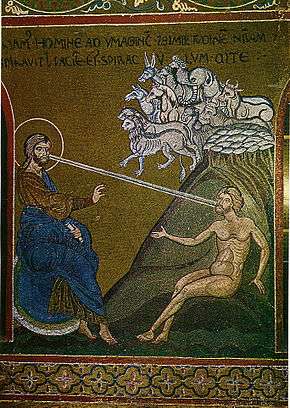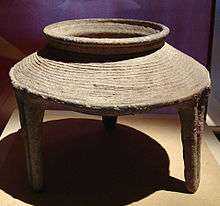6th millennium BC
| Millennia: | |
|---|---|
| Centuries: |
|
During the 6th millennium BC, agriculture spread from the Balkans to Italy and Eastern Europe, and also from Mesopotamia to Egypt. World population was essentially stable at numbers ranging between approximately 5 and 7 million.
Events

Byzantine Calendar illustrating 1 September 5509 BC (the calendar is from the 12th century CE).

Yangshao culture
- A massive volcanic landslide off Mount Etna, Sicily, caused a megatsunami that devastated the eastern Mediterranean coastline on the continents of Asia, Africa and Europe.[1]
- c. 6000 BC: The entire 6th millennium was a part of the Holocene climatic optimum (so were the 4th, 5th, and 7th millennia). This was a warm period also known as the Atlantic period and was characterized by minimal glaciation and high sea levels. (McEvedy)
- c. 6000 BC: The Chalcolithic comes to the Fertile Crescent. (Roux 1980) First use of copper in Middle East. (Bailey 1973)
- c. 6000 BC: Fully Neolithic agriculture has spread through Anatolia to the Balkans. (1967 McEvedy)
- c. 6000 BC: Junglefowl kept in India.
- c. 6000 BC: Female figurines holding serpents are fashioned on Crete and may have been associated with water, regenerative power and protection of the home.
- c. 6000 BC: Equidae (horses) disappear from the Americas.
- c. 5900 BC: Vinča culture emerges on the shores of lower Danube.
- c. 5800 BC: Beginning of the Dadiwan culture in China.
- c. 5800 BC: The Hassuna culture in Mesopotamia (t. 5500 BC), with the earliest version of stamp seals. (Roux 1980)
- c. 5760 BC: The volcano Puy de Dôme in France erupts.
- c. 5677 BC: Cataclysmic volcanic eruption of 12,000-foot (3,700 m) high Mount Mazama creates Oregon's Crater Lake[2] when the resulting caldera fills with water. It is the largest single Holocene eruption in history of the Cascade Range, with a Volcanic Explosivity Index of 7.
- c. 5600 BC: Beginning of the desertification of North Africa, ultimately leading to the creation of the Sahara desert. This process may have spurred migration to the region of the Nile in the east, thereby laying the groundwork for the rise of Egyptian civilization.
- c. 5600 BC: Favored date of the Black Sea deluge hypothesis.
- c. 5600 BC: The Red Paint People become established in the region from present-day Labrador to the state of New York.
- 5509 BC: The Byzantine calendar dates the Genesis creation narrative to 1 September of this year.
- c. 5500 BC: Beginning of the Cucuteni-Trypillian culture in the region of modern-day Romania, Moldova, and southwestern Ukraine.
- c. 5500 BC: Beginning of Tell Zeidan in Syria (Ubaid).
- c. 6th millennium BC: Beginning of Teppe Hasanlu in Iran.
- c. 6th millennium BC: Beginning of Zayandeh River Culture in Iran, including Sialk.
- c. late 6th and early 5th millennium BC: Beginning of Samara culture at the Samara bend region of the middle Volga, Russia.
- c. 5500–4800 BC: Samarra culture in Iraq.
- c. 5500 BC: Beginning of the Xinle culture in China.
- c. 5500 BC: Agriculture started in Ancient Egypt.
- c. 5500 BC: Predynastic stage of Prehistoric Egypt (other date is 4350 BC).
- c. 5450 BC: Volcano Hekla eruption.
- c. 5400 BC: Beginning of the Zhaobaogou culture in China.
- c. 5400 BC: Irrigation and the beginning of the Sumerian civilization in Southern Iraq.
- c. 5300 BC: Beginning of the Beixin culture in China.
- c. 5200 BC: Beginning of human inhabitation and settlements in Malta.
- c. 5000 BC: Beginning of the Hemudu culture in China.
- c. 5000 BC: Beginning of the Daxi culture in China.
- c. 5000 BC: Beginning of the Majiabang culture in China.
- c. 5000 BC: Beginning of the Yangshao culture in China.
- c. 5000 BC: Farming reached central and north Europe.
- c. 5000 BC: Metsamor Armenia neolithic stone circles.
Environmental changes
| Holocene Epoch |
|---|
| ↑ Pleistocene |
| Holocene |
Main article: Atlantic (period)
- c. 7000 BC: Beginning the Holocene climatic optimum.
- c. 6000 BC: Doggerland, the land bridge connecting England with the rest of Europe, disappears beneath the waters of the North Sea and the English Channel.
- c. 5600 BC: According to the Black Sea deluge hypothesis, the Black Sea floods with salt water. Some 3000 cubic miles (12,500 km3) of seawater is added, significantly expanding the body of water and transforming it into a sea from a fresh-water landlocked lake.
Inventions, discoveries, introductions
- c. 6000 BC: Cycladic culture begin to use a coarse local type of clay to make a variety of objects.
- c. 6000 BC: Brick building was taking place at modern-day Çatalhöyük, Turkey.[3]
- Agriculture appears in the valley of the Nile.
- Rice cultivated in Asia.
- c. 6000 BC–5000 BC: Wine is created for the first time in Iran.
- c. 5500 BC: Earliest evidence of cheese-making (Kujawy, Poland).[4]
- c. 5000 BC: Agriculture may have begun in the Americas, in complete isolation from the Old World.[3]
- Artifacts of stone were supplemented by those of metal, and the crafts of basketry, pottery, weaving (Africa).
- Dead were buried in a fetal position, surrounded by the burial offerings and artifacts, facing west (Africa).
- Decorated, black-topped clay pots and vases; bone and ivory combs, figurines, and tableware, are found in great numbers (Africa).
- Jewelry of all types and materials (Africa).
- Objects began to be made not only with a function, but also with an aesthetic value. (Africa)
- Organized, permanent settlements focused around agriculture. (Africa)
Cultural landmarks
- c. 5700 BC: Samarra culture at Mesopotamia (present day Iraq) begins (c. 5700 BC – 4900 BC C-14, 6640 BC – 5816 BC calBC).
- c. 5500 BC: Pottery at Mehrgarh in current-day Balochistan, Pakistan.
- c. 5100 BC: Temples founded in southern Mesopotamia.
- Danubian culture
References
- ↑ Pareschi, M. T.; Boschi E.; Favalli M. (2006). "Lost tsunami". Geophysical Research Letters. 33 (22): L22608. Bibcode:2006GeoRL..3322608P. doi:10.1029/2006GL027790.
- ↑ Zdanowicz, C. M.; Zielinski, G. A.; Germani, M. S. (1999). "Mount Mazama eruption; calendrical age verified and atmospheric impact assessed". Geology. 27 (7): 621–624. Bibcode:1999Geo....27..621Z. doi:10.1130/0091-7613(1999)027<0621:MMECAV>2.3.CO;2.
- 1 2 Roberts, J: History of the World. Penguin, 1994.
- ↑ "Art of cheese-making is 7,500 years old". Nature. 12 December 2012.
This article is issued from Wikipedia - version of the 10/5/2016. The text is available under the Creative Commons Attribution/Share Alike but additional terms may apply for the media files.